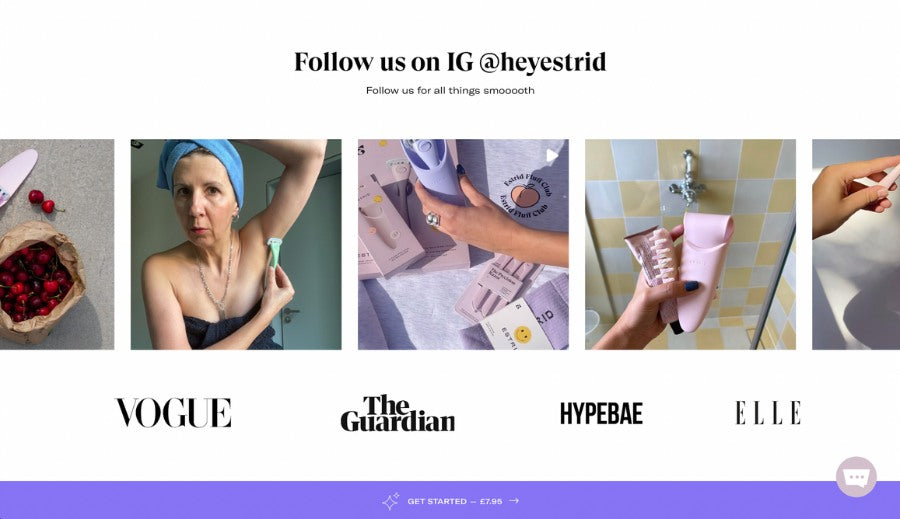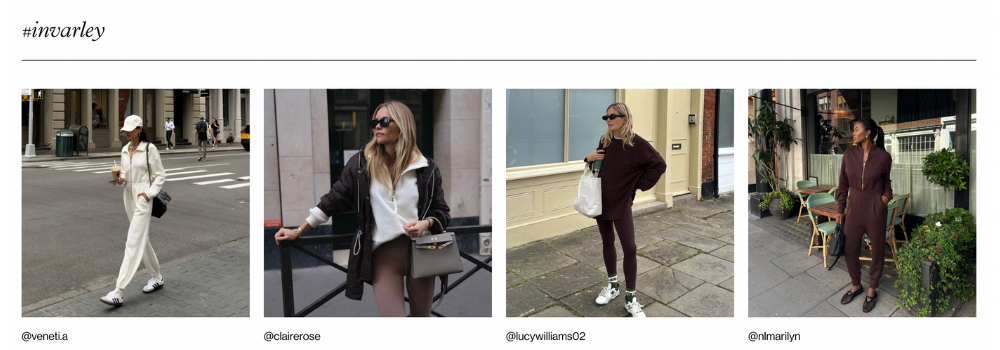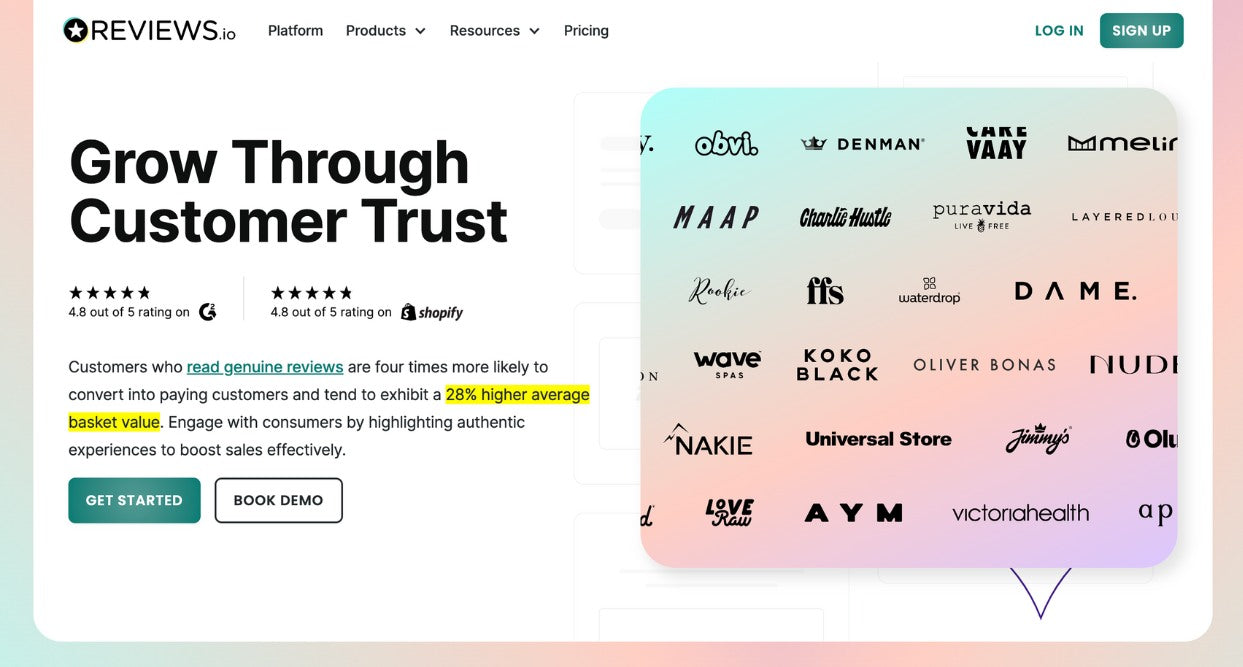Have you ever been drawn to a product because of a real-life photo shared by an actual customer?
Join the club. A massive 79% of consumers say user-generated content (UGC) impacts their purchasing decisions.
For that reason (and many other equally impressive statistics), ecommerce brands are taking full advantage of using UGC on their online store to drive sales.
We’re showing you real-world examples of how UGC can be used effectively in your online shop.

Table of Contents:
- What Counts As UGC?
- UGC in Action: Ecommerce Examples
- Key Places for UGC On Your Website
- UGC's Impact on Conversion Metrics
- The Link Between UGC and Conversions
- Reasons why UGC is a Great Conversion Tool for Shopify Merchants
- Implementing UGC: Best Practices for Ecommerce
What counts as UGC?
It’s not as simple as it used to be.
Originally, UGC (short for User-Generated Content) started as content — be it text, images, videos, reviews — created and shared organically by unpaid contributors on their own personal social media accounts, blogs or even forums.
These were genuine fans or users of a brand that took to places like YouTube, Instagram or Reddit to share what they loved (or didn’t love) with their audiences. Specific examples might include an Instagrammer enthusiastically unboxing a new purchase, or a YouTuber raving about a product they love.
This genuine type of content gave brands brilliant organic visibility and built strong trust in potential customers. Now things have changed.
Along with classic UGC, today we see evolutions like 'staged UGC' and 'brand UGC' where brands and influencers have strategically tapped into the aesthetic and authenticity of organic UGC, but with a more controlled touch.
Below, consider two TikTok screenshots centred around the same product—Grind coffee.

On the left, we have content by @phoebekibble: a TikTok user making a Grind iced coffee in her kitchen setting. It has that unmistakable unscripted, organic feel typical of authentic UGC.
Contrast this with the right, where Grind's official TikTok showcases a more polished rendition of their iced coffee. It borrows from the UGC vibe but has that professional sheen indicative of brand influence.
Both examples count as UGC and show how we can categorise UGC into distinct types:
Authentic UGC: The original form of UGC. Authentic. Real. Unfiltered. Unpaid. It’s different types of content (images, videos, reviews) that’s shared online organically.
Staged UGC: The middle ground. This is where user content (including paid influencer collaborations) gets a professional touch-up. It could be an unboxing video under perfect lighting or an influencer's casual chat about a product they "just happened to come across." The core idea? Keep it genuine but elevate its presentation.
Brand UGC: This is where brands wear the content creator hat. Crafting content that looks and feels like UGC is the idea. Think of a brand photo that's snapped to mirror a customer's candid click. Or maybe a testimonial video that channels genuine user feedback vibes. The aim isn't to deceive, but rather to merge the brand's voice with the much-loved UGC style.
Now we've got the technicalities and definitions out of the way, let’s look at some specific UGC examples in the context of ecommerce sites.
Specific examples of UGC on ecommerce websites
As Shopify Website Designers and Developers, we are particularly interested in the ways UGC can be used on ecommerce sites.
Below is a list of different types of UGC implementations brands use on their store’s pages:
- Customer Reviews & Ratings
- User-Submitted Product Photos
- Integrated Unboxing Videos
- Usage Galleries
- Product Tutorial & How-to Videos
- UGC Centric Social Media Feeds
Customer Reviews & Ratings
Fundamental to most ecommerce platforms, recent, real, and direct feedback on products provide valuable insights for potential buyers. Typically, we see reviews and ratings displayed on product pages or homepages (like the example below, taken from Baa Baby's product pages).

User-Submitted Product Photos
These are authentic visuals of products in real-world settings. These candid shots, although not professionally taken, give prospective customers a realistic view of a product's appearance and utility. Tahini brand EatSoCo uses user generated images along with text reviews and ratings on their homepage. Appliance brand Sage, use them on their product pages.

Integrated Unboxing Videos
I’m guessing we’ve all seen them - unveilings of products, capturing initial reactions and insight into product quality. It's not just about showcasing what's inside the box but capturing the excitement, anticipation, and satisfaction of the first encounter with a product. We often see these videos used as part of product image galleries or in review feeds - as seen on Skims below.

Usage Galleries
UGC usage galleries are especially popular for fashion or lifestyle products. They are basically photo or video galleries showing how customers are using or styling their purchases. An example is the Good Fabrics homepage, where real users display how they've made and styled their fabrics.

Product Tutorial & How-to Videos
A step beyond just showcasing a product. Users or the brand itself create video guides on how to use the product. For instance, Golde uses a UGC-styled video to demonstrate matcha preparation at home on their product page.

UGC Centric Social Media Feeds
A dynamic or curated feed of user-submitted content. These feeds can be integrated directly into the ecommerce site, providing a continuous stream of fresh content and user engagement. Brands like Estrid and Varley have harnessed UGC by showcasing a gallery of user content on their homepage, offering a blend of brand and genuine user content.


9 places where UGC can be added on your website
We are not recommending UGC in every single one of these places. This list provides potential areas on your website where UGC might be integrated.
1. Homepage
- Featured Reviews: Highlight top reviews or testimonials to build immediate trust.
- Trust Seals from Review Platforms: Badges from sites like Reviews.io that validate a brand's credibility through customer feedback.
- User Photo Carousel: A slideshow of customer photos showcasing the products in various settings.
- Social Media Feed: Live or curated feed displaying posts from customers tagging the brand or specific campaign hashtags.
2. Product Pages
- Customer Reviews Section: Reviews with star ratings providing insights into product quality, fit, and overall satisfaction.
- User-Submitted Photos: Real-life photos from customers, offering a genuine look at the product outside of professional shots.
- "As Seen On" Section: Photos of influencers or general customers who have featured the product on their social channels.
- Video Reviews or Demos: UGC videos highlighting product features, usage, or unboxing experiences.

Zalando using full UGC style gallery for products on their online store
"Displaying UGC as a shopping option is, in my opinion, one of the most significant considerations for brands. It caters to a diverse range of shoppers, including those who rely on seeing a product in its real context, possibly on individuals who share similar attributes such as body type or skin tone. These shoppers are well-informed about studio photography's limitations in accurately representing a product." Richard Ball, UGC Expert from REVIEWS.io
3. Checkout Page
- Review Snippets: Showcase brief reviews or star ratings of the product in the cart to reassure buyers of their choice.
- User Photos of Purchased Item: Visual reinforcement showing the product as enjoyed by other customers.
4. Category or Collection Page
- Highlighted UGC: Showcase photos or reviews of best-sellers or customer favourites within the category.
5. Landing Pages
- UGC Spotlight: If you are running paid ads on certain products that require their own landing pages - spotlight specific user reviews, photos, or videos relevant to the campaign or product launch.
6. Thank You Page
- UGC Encouragement: Prompt new customers to share their own photos, reviews, or experiences with their purchase.
7. Blog or Content Pages
- UGC Integration: Weave in customer photos, quotes, or experiences relevant to the article topic.
8. Footer or Sidebar
- Recent UGC Carousel: Rotate recent reviews, photos, or UGC campaign highlights.
9. Email Signup Page
- UGC Testimonials: Feature user stories or quotes detailing the benefits of joining the brand's email community.
UGC's Impact on Conversion Metrics
The value of UGC isn't just in its authenticity. It's also a driver for online sales. Let's get into some statistics to understand its real impact on conversions.
We looked at recent data from a 2022 study that surveyed over 1,200 ecommerce platforms using UGC tools. It revealed the following:
- Baseline Conversion Rates - sites implementing UGC witnessed an average conversion rate of 3.2%.
- Browsing Boost - visitors who came across UGC on these sites experienced an uplift in conversion likelihood by 3.8%.
- Impact of Active Engagement - the real game-changer was when users not just viewed but interacted with UGC. Their conversion rates skyrocketed, marking an increase of 102.4%.
The link between UGC and conversions
But why exactly do consumers like UGC? What accounts for these numbers?
The connection between UGC and conversions is more than just looking at raw numbers. We know that behind the conversion statistics is human behaviour that’s driving those purchasing decisions.
Authenticity over advertising
As consumers, we are bombarded with advertisements from every corner of the internet. Amidst this noise, authenticity continues to stand out.
When shoppers see real people vouching for a product, they inherently trust it more than a brand's claims. Similarly, authentic presentations of a product also have the power to sway potential buyers, making them more inclined to make a purchase.
Social influence
We are social creatures. We often value the opinions, choices, and endorsements of people we know or people we come into contact with.
When potential buyers see friends, family, or even strangers sharing positive experiences with a product, they are more likely to consider that product trustworthy. This kind of peer validation can significantly influence purchasing decisions.
Builds a real, visual story:
UGC, especially photos and videos, provides a tangible, visual representation of the product in action. Shoppers can see how the product fits into everyday life, how it’s used, or even how it looks in different settings (just think of the rise in POV angles in marketing visuals). This not only demystifies the product but also helps potential buyers visualise themselves using it.
Reduces ‘buying anxiety’
One big barrier to online shopping is uncertainty. Do I really trust the brand's product photos? Will it look as it does in the pictures? Are these products good quality? Customers can’t feel, try, or test a product before buying it online, but UGC acts as a reassuring factor. When potential buyers see other customers satisfied with their purchase, it reduces any kind of purchase anxiety to push them much closer to conversion..
UGC & Shopify: Reasons UGC is a great conversion tool for Shopify merchants
If your ecommerce store is on Shopify you’re in luck.
Shopify's user-friendly nature makes it very simple for brands to integrate UGC into their website. The platform offers loads of apps for UGC collection, display and management.
A UGC app that we always tend to recommend to all our clients is REVIEWS.io. Chances are you've heard of them already, but check out their case study pages to see how they are helping ecommerce brands.

"The decision to incorporate UGC will largely depend on the brand's image, goals, and objectives. Some brands may prioritize the authenticity and relatability that UGC provides, while others may opt for a more polished, studio-centric approach. It's essential for brands to find the right balance that resonates with their target audience and aligns with their overall brand strategy." Richard Ball, UGC Expert from REVIEWS.io
Implementing UGC: Best Practices for Ecommerce
Integrating UGC is definitely a lot more than just randomly placing customer reviews or user photos on your website.
Here are some best practices for ecommerce stores when incorporating UGC:
- Get user permission: Always get explicit permission from the content creators before showcasing their content on your website. It not only respects their rights but also fosters trust between the brand and the user community.
- Keep it authentic: While curating content, ensure that you maintain the authenticity of UGC. It's alright if a photo isn't picture-perfect. That's what makes it genuine and relatable.
- Highlight diverse user experiences: Display content from a diverse range of users to make your product appealing to a broader audience. This ensures inclusivity and showcases the product’s versatility.
- Don’t neglect responsive design: Ensure the UGC you integrate looks good and functions well on mobile devices. A significant portion of online shoppers use mobile, so the content must adapt seamlessly.
- Update regularly: Keep the UGC feed updated. Fresh content keeps potential customers engaged and shows that people are continuously interested in and buying your products.
- Encourage more UGC: Run campaigns or incentives to encourage your customer base to share their product experiences. This can be discounts, feature opportunities, or even exclusive deals.
"The review invitation occurs at a unique point in the customer journey – usually when they are at their happiest after receiving their order. Requesting User-Generated Content (UGC) at this stage is crucial for merchants looking to enhance their UGC presence. Displaying reviews alongside UGC is of utmost significance. As customers peruse reviews, they often become accustomed to positive feedback. Therefore, it is essential to appreciate the added value and authenticity of a review that includes UGC. Images provided by real customers not only convey authenticity but also showcase the product in a new perspective, illustrating how it is used and fits into customers' lives." Richard Ball, UGC Expert from REVIEWS.io
- We advise quality over quantity: While it's tempting to showcase all the UGC you can get your hands on, prioritise quality. High-quality, relevant content will resonate more with potential buyers.
- Integrate with social media: Make it easy for users to share their content directly from your site to their social platforms. This not only boosts their engagement but also provides you with organic visibility.
- Analyse & iterate: Regularly analyse how UGC is performing on your website. You can even run A/B testing to determine placement, type, and the amount of UGC that's going to drive the best conversion rates.

